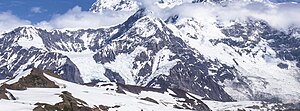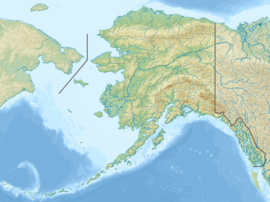Earth:Haydon Peak
| Haydon Peak | |
|---|---|
 South aspect | |
| Highest point | |
| Elevation | 11,924 ft (3,634 m) [1] |
| Prominence | 1,674 ft (510 m) [1] |
| Parent peak | Mount Saint Elias (18,008 ft)[1] |
| Isolation | 3.04 mi (4.89 km) [1] |
| Listing | Highest major summits of the US Mountain peaks of Alaska Major summits of North America |
| Coordinates | [ ⚑ ] : 60°15′40″N 140°59′17″W / 60.2610400°N 140.9880154°W [2] |
| Naming | |
| Etymology | Henry E. Haydon |
| Geography | |
| Country | United States |
| State | Alaska |
| Borough | Yakutat[2] |
| Protected area | Wrangell–St. Elias National Park[3] |
| Parent range | Saint Elias Mountains[3][2] |
| Topo map | USGS Mount Saint Elias B-8[2] |
| Geology | |
| Age of rock | Mesozoic[4] |
| Type of rock | Schist[4] |
| Climbing | |
| Easiest route | Expedition climbing |
Haydon Peak is an 11,924-foot-elevation (3,634-meter) mountain summit in Alaska, United States.
Description
Haydon Peak is part of the Saint Elias Mountains in Wrangell–St. Elias National Park and Preserve.[3] The glaciated peak is located 3.5 miles (5.6 km) southwest of Mount Saint Elias and 66 miles (106 km) northwest of Yakutat, Alaska.[5] The mountain is surrounded by the Libbey Glacier to the east and Tyndall Glacier to the west. Precipitation runoff and glacial meltwater from the mountain flows south to the Gulf of Alaska. Topographic relief is significant as the summit rises 8,300 feet (2,530 m) above the head of Libbey Glacier in two miles (3.2 km).
History
The mountain was named "Hadon Peak" in 1888 by mountaineer Harold Ward Topham for Mr. and Mrs. Henry E. Haydon.[5] Henry Haydon was Secretary of the District of Alaska at the time of Topham's expedition to Mount Saint Elias.[2] Topham's failed 1888 expedition only reached an elevation of 11,460-feet on Mt. Saint Elias' south side,[6] so a close view of Haydon Peak was possible.[7] The mountain's toponym was officially adopted in 1917 by the U.S. Board on Geographic Names.[2]
Climate
Based on the Köppen climate classification, Haydon Peak is located in a tundra climate zone with long, cold, snowy winters, and cool summers.[8] Weather systems coming off the Gulf of Alaska are forced upwards by the Saint Elias Mountains (orographic lift), causing heavy precipitation in the form of rainfall and snowfall. Winter temperatures can drop below −10 °F with wind chill factors below −20 °F. This climate supports several glaciers surrounding this peak. The months May through June offer the most favorable weather for viewing or climbing.
See also
- List of mountain peaks of Alaska
- Geography of Alaska
References
- ↑ Jump up to: 1.0 1.1 1.2 1.3 "Haydon Peak - 11,924' AK". https://listsofjohn.com/peak/32886.
- ↑ Jump up to: 2.0 2.1 2.2 2.3 2.4 2.5 "Haydon Peak". United States Geological Survey. https://geonames.usgs.gov/apex/f?p=gnispq:3:::NO::P3_FID:1403255.
- ↑ Jump up to: 3.0 3.1 3.2 "Haydon Peak, Alaska". http://www.peakbagger.com/peak.aspx?pid=29660.
- ↑ Jump up to: 4.0 4.1 Gary R. Winkler, A Geologic Guide to Wrangell–Saint Elias National Park and Preserve, Alaska, 1999.
- ↑ Jump up to: 5.0 5.1 Donald J. Orth, Dictionary of Alaska Place Names, U.S. Government Printing Office, 1967, page 411.
- ↑ Israel C. Russell, An Expedition to Mount St. Elias, Alaska, DigiCat, 2022.
- ↑ William Williams (1942). "Reminiscences of Mt. St. Elias". American Alpine Journal. https://publications.americanalpineclub.org/articles/12194235500/Reminiscences-of-Mt-St-Elias.
- ↑ Peel, M. C.; Finlayson, B. L.; McMahon, T. A. (2007). "Updated world map of the Köppen−Geiger climate classification". Hydrol. Earth Syst. Sci. 11 (5): 1633. doi:10.5194/hess-11-1633-2007. ISSN 1027-5606. Bibcode: 2007HESS...11.1633P.
External links
- Haydon Peak: Weather forecast
- First woman to summit Haydon Peak: Americanalpineclub.org
Template:Geographic Location 2
 |



